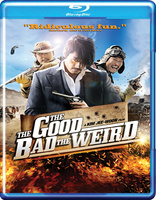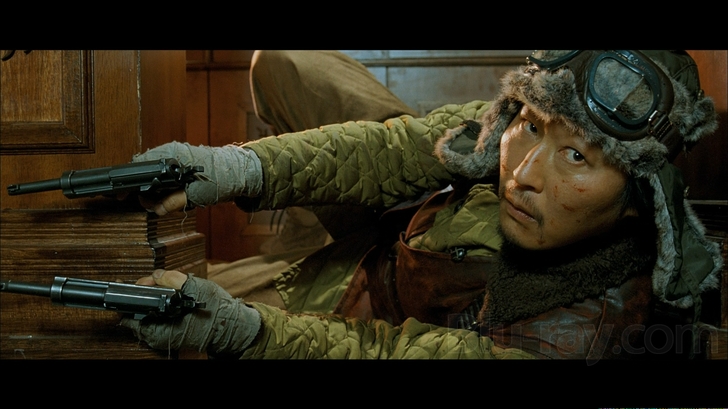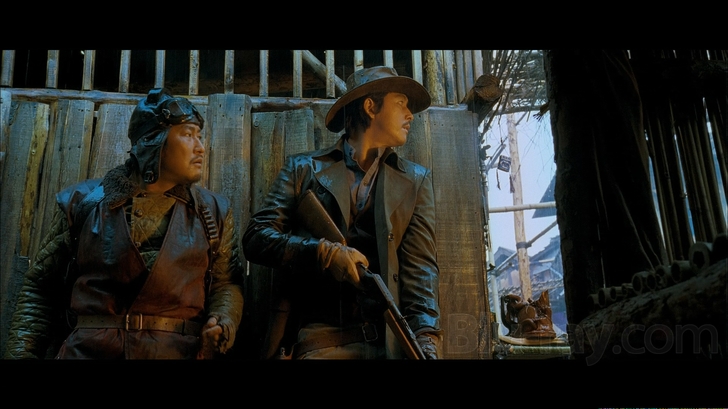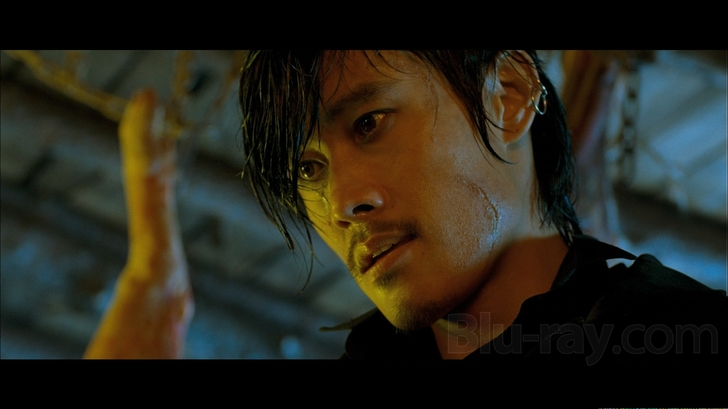The Good, the Bad, the Weird Blu-ray Movie
HomeThe Good, the Bad, the Weird Blu-ray Movie 
Joheunnom nabbeunnom isanghannomIFC Films | 2008 | 130 min | Rated R | Aug 17, 2010

Movie rating
7.6 | / 10 |
Blu-ray rating
| Users | 4.4 | |
| Reviewer | 3.5 | |
| Overall | 4.0 |
Overview
The Good, the Bad, the Weird (2008)
Set in 1930s Japanese occupied Manchuria, tells the story of three Joseon mounted bandits who get their hands on a treasure map, only to be pursued by the army of national independence, who believe that the outlaws have a map for a new railway to be built by the Japanese army.
Starring: Song Kang-ho, Lee Byung-hun, Jung Woo-sung, Ryu Seung-su, Zhang QiDirector: Kim Jee-woon
| Foreign | Uncertain |
| Western | Uncertain |
| Comedy | Uncertain |
| Adventure | Uncertain |
| Action | Uncertain |
Specifications
Video
Video codec: MPEG-4 AVC
Video resolution: 1080i
Aspect ratio: 2.35:1
Original aspect ratio: 2.39:1
Audio
Korean: DTS-HD Master Audio 5.1
Korean: Dolby Digital 2.0
Subtitles
English, English SDH, Spanish
Discs
50GB Blu-ray Disc
Single disc (1 BD)
Playback
Region A (locked)
Review
Rating summary
| Movie | 4.0 | |
| Video | 3.5 | |
| Audio | 4.5 | |
| Extras | 2.0 | |
| Overall | 3.5 |
The Good, the Bad, the Weird Blu-ray Movie Review
Emphasis on Good and Weird
Reviewed by Casey Broadwater August 28, 2010The western is just as mutable as any other genre, its conventions constantly adapted to suit the times. John Ford perfected the black hat versus white hat tale with films like Stagecoach and The Searchers. Akira Kurasawa then saw in the western an analog for Japan’s native samurai culture, tweaking genre tropes for Yojimbo, Seven Samurai and others. The spaghetti western was born when Sergio Leone remade Yojimbo as A Fistful of Dollars, infusing the iconography of Ford’s Old West and the moral relativism of Kurasawa’s ambivalent, side-swapping hero with a distinctly European filmmaking aesthetic. Later, Sam Peckinpah and Alejandro Jodorowsky repurposed the genre, giving us hyper-violence and the “acid western” with The Wild Bunch and El Topo, respectively. Recently, Asian directors have had another crack, producing revisionist, pop-culture mash-ups like Sukiyaki Western Django and the far superior The Good, The Bad, The Weird. Critics have called the latter film, by Korean director Kim Ji-woon, a “Kimchi western,” but it’s more of a bibimbap, a cinematic hodgepodge with ingredients from numerous sources.

You lookin' at ME?
As the title implies, the basic outline of the plot has been traced directly from Sergio Leone’s The Good, The Bad, and The Ugly, only, instead of being set in the west during the American Civil War, the film takes place in the Japanese-occupied Manchuria of the mid-1930s. Here, the Lee van Cleef role—The Bad—is played by actor Lee Byung-hun as Park Chang-yi, a merciless killer who has been hired to steal a treasure map from a Japanese bigwig traveling by train across the Gobi desert. Chang-yi stops the train, terrorizes the passengers, and scavenges for the map, but he’s too late—it’s already been stolen by The Weird, petty thief Yoon Tae-goo (Song Kang-ho), who has taken off across the barren landscape on a motorcycle with Man-gil (Ryoo Seung-soo), his best friend and partner in crime. Following close behind is The Good, bounty hunter Park Do-won (Jung Woo-sung), who sees an opportunity to claim the reward on multiple criminals. Man-gil tries to convince Yoon Tae-goo to sell the map, as they don’t even know what the treasure is, but The Weird, determined to find out for himself, sets off on a dangerous adventure toward the X, pursued not just by The Good and The Bad, but also by a rough and tumble outfit of Manchurian bandits and the entire Imperial Japanese army. You can bet the quest ends in a Mexican standoff, tense and protracted, with lots of tight Leone-esque close-ups of the characters’ darting, anxious eyes.
The Good, The Bad, The Weird, hereafter referred to as GBW, was Korea’s biggest budgeted movie—until 2009’s Tidal Wave—and it shows. Previously known for gangster drama A Bittersweet Life and intimate familial horror film A Tale of Two Sisters, director Kim Ji-woon has pulled out all the stops to make a summer blockbuster that rivals anything released by Hollywood. And GBW definitely has an epic Hollywood adventure vibe —action-packed, filled with unbelievable set pieces, and somehow both glossy and gritty. Although the title name-checks Leone’s western masterpiece, the film takes equal influence from Steven Spielberg—specifically Raiders of the Lost Ark—from a travel montage where our hero’s path is sketched out along the map, to the Japanese army, making a good stand-in for the Nazis of the Indiana Jones movies. Like Raiders, there’s not much political commentary here—although there are a few references to the Korean independence movement—as the focus is fully on the action and adventure. My sole complaint, then, is that the film lacks depth; the characters are as one-dimensional as their titular names imply, and the story holds precious few surprises. (One being the revelation of the treasure, which does have a contemporary twist.)
Simplicity of the story aside, GBW is a lavish production. The sets, particularly the train, an opium den, and the Ghost Market—a haven for bandits and ne’er-do-wells—are impeccably dressed with period details, looking convincingly lived in and worn down. Kim Ji-woon uses these locales to stage frenetic and frequently clever action sequences. There’s gunplay galore, intense and stylishly shot. The violence is brutal—one knife fight had me cringing in my seat—but it’s also cartoonish, so over the top at times that you can’t take it too seriously. (For example, within a single scene, two bad guys get speared through the ass, painfully but hilariously.)
If he was a cat, The Weird would’ve exhausted all of his nine lives by the end of the film; he’s constantly making narrow, clumsily executed escapes. In this, he’s a bit like Indiana Jones, only even more of a comic figure. If you’re a fan of Korean cinema, you’ll recognize Song Kang-ho from a number of films—The Host and Thirst most notably—and here he plays his typically jocular role, a character who makes us laugh but who is also the emotional center of the film, the audience’s point of connection. The Weird becomes the protagonist, not The Good, as you might expect, and he’s a fun character to follow. Lee Byung-hun’s The Bad simmers dastardly, but he’s too much of a pretty boy to exude real menace. And Jung Woo-sung as The Good? Well, try though he might to stoically grimace into the sunset, he’s no Clint Eastwood—no one could fill those boots. It doesn’t matter, though. GBW doesn’t take itself too seriously. It’s a playful, self-conscious homage to the western genre, served up Korean style. If a sequel ever goes into the works, I’d be more than glad to have seconds.
The Good, the Bad, the Weird Blu-ray Movie, Video Quality 

Yes, what you've heard is true. MPI have brought The Good, The Bad, The Weird to Blu-ray in the U.S. with a non-progressive 1080i transfer, using the AVC codec. I think we all can agree that unless the material was shot natively in 1080i video, there's no reason why a feature film should have an interlaced transfer on Blu-ray, unless, due to impossible rights issues, a 1080p master can't be procured. Thankfully, though, this is one of the better 1080i releases I've seen in terms of picture quality. You will notice some slight motion artifacts, especially if you have a larger screen, and you can even detect a distinct combing effect when the subtitles appear and disappear. There are also a few instances when shimmer and aliasing is visible when the image displays close parallel lines. Thankfully, though, none of these problems are absolute deal-breakers. Sure, it makes no sense at all that every other territory gets a 1080p version of the film while the U.S. is stuck with an 1080i transfer, but the quirks associated with interlacing are rarely distracting. Clarity is strong throughout, and while it looks like some mild edge enhancement has been used to boost sharpness, it never gets to the point where haloes start to form around hard lines. The tight facial close-ups—borrowed from Sergio Leone—are very crisp, and you'll be able to make out every pore and bit of stubble on the actors' faces. Color is mildly stylized, with a high-contrast look that works well for the neo-Western vibe, but black levels are somewhat inconsistent, deep outdoors, but occasionally hazy during nighttime scenes. A thin layer of grain is present—no DNR here—and aside from the aliasing and motion artifacts, there are no other compression-related issues. It's a shame we couldn't have gotten a proper transfer, but The Good, The Bad, The Weird probably looks better than you might expect when you hear "1080i."
The Good, the Bad, the Weird Blu-ray Movie, Audio Quality 

This release makes up for the 1080i transfer with a hefty, effect-laden Korean DTS-HD Master Audio 5.1 surround track that kicks some serious Asian cowboy ass. The movie is all action, all the time, and the audio has no trouble keeping up. Out of control trains, roaring Jeeps, and bursting artillery shells keep the LFE channel activated, pumping out gut-quaking tremors of low-end goodness. The rear channels are constantly filled with ambience and effects, from village chatter and rain falling all around to massive shootouts where extremely potent gunshots ping, crack, and kra-pow in all directions. Let's just say that the gun battle in the Ghost Market is sonically intense. Cross- channel movement are handled with deftness as well, so much so that there were a few instances when I could've sworn something horrible was going on out in the road behind my house. All of this aural insanity could easily overwhelm the dialogue, but that's not the case—voices are effortlessly balanced in the mix, and you'll never once have to touch your remote to boost or tamp down the volume. The score borrows heavily from Morricone, but it's thoroughly modern as well, with electronic accents and even a few hip-hop-ish beats thrown in for good measure. No complaints at all on the audio front.
The Good, the Bad, the Weird Blu-ray Movie, Special Features and Extras 

Trailer (1080p, 2:21)
So, a 1080p trailer, but no 1080p film?
Behind the Scenes (SD, 15:02)
Straight up behind the scenes footage—no interviews, no commentary—just a look at the fantastic
sets and the innovative ways that certain shots were achieved.
Cannes Highlight Reel (SD, 3:02)
Some footage from the cast and director's appearance at Cannes.
Making of #1 (SD, 3:22) and Making of #2 (SD, 1:02)
Two extremely brief featurettes with additional on-set footage and interviews with the
director.
Interviews (SD)
Includes brief interviews with director Kim Jee-woon (3:14) and actors Song Kang-ho (2:41), Lee
Byung-hun (2:57), and Jung Woo-sung (2:45).
The Good, the Bad, the Weird Blu-ray Movie, Overall Score and Recommendation 

Sergio Leone meets Steven Spielberg in Kim Jee-woon's The Good, The Bad, The Weird, a rollicking "western" adventure set in the Japanese-occupied Manchuria of the 1930s. Some harsher critics might says the film is all empty action—the story is as simple as they come and there's not much that could be called character development—and while I wouldn't necessarily disagree, GBW is far more fulfilling than your average summer blockbuster. (And far less reliant on CGI. The practical stuntwork and effects here are fantastic.) Think of it as a three-way cross between The Man With No Name trilogy, Raiders of the Lost Ark, and Korea's new wave of stylistically driven cinema. Recommended!
Other editions
The Good the Bad the Weird: Other Editions
Similar titles
Similar titles you might also like

Let The Bullets Fly
Rang Zi Dan Fei
2010

Operation Mekong
湄公河行动 / Mei Gong he xing dong
2016

The Big Gundown
La resa dei conti
1966

The Adventurers
2017

Django 4K
Special Edition
1966

Operation Condor 2
The Armour of God / Lung hing foo dai
1986

Kung Fu Yoga
2017

Chinese Zodiac
十二生肖 / Armour of God III: Chinese Zodiac / CZ12
2012

A Touch of Zen
俠女 / Xia nü
1971

Dragon Inn
龍門客棧 / Long men kezhan
1967

Project A
'A' gai wak
1983

Railroad Tigers
2016

Millionaires’ Express
富貴列車 / Foo gwai lit che / Shanghai Express | Standard Edition
1986

Greed in the Sun
Cent mille dollars au soleil
1964

Furie
Hai Phuong
2019

Kundo
2014

A Fistful of Dynamite
Giù la testa / Duck, You Sucker
1971

A Bullet for the General
¿Quien sabe?
1967

Death Rides a Horse
Da uomo a uomo | Special Edition
1967

Peking Opera Blues 4K
Do ma daan / Dao ma dan / 刀馬旦 / Hong Kong Cinema Classics #7
1986
